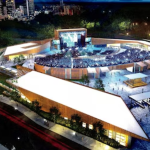By Tashi McQueen,
AFRO Political Writer,
tmcqueen@afro.com
A $2 million investment from the U.S. Department of Transportation’s Reconnecting Communities Program will help bridge West Baltimore communities currently divided by the “Highway to Nowhere” which extends from N. Warwick Avenue to Martin Luther King Jr Blvd.
Located in the 7th congressional district, the “Highway to Nowhere” is the failed expansion of Interstate-70 to connect with Interstates 83 and 95 that caused the displacement of 1,500 residents at the time of its construction more than 50 years ago.
Rep. Kweisi Mfume (D-Md.) told the AFRO that “more than three dozen businesses at the time disrupted” and that the highway has acted as a “sort of physical divider between the communities of Poppleton and Harlem Park and others.”
Mfume said congressional support for the legislative proposal grew out of the 2021 introduction of the Reconnecting Communities Act and the work of Maryland’s current congressional delegation to pass the Infrastructure Investment and Jobs Act (Bipartisan Infrastructure Law).
“Baltimore could not wait another 50 years to have the federal government make right what was a very big wrong,” Mfume said.
Reversing the urban planning error will take a while, other officials said.
“We probably won’t see physical improvement of the area for eight to 10 years,” said Theo Ngongang, of the Baltimore Department of Transportation.
Throughout the planning process, Mfume said they will seek a “robust public engagement,” saying the project will fail if the community is left out of the conversation.
Mfume hopes displaced community members will reconnect with the area but said it might be difficult.
“Many of those displaced have reached out to the office, but the larger problem is a number of those persons have died or moved away from the area and do not want to return,” said Mfume.
A community member of West Baltimore spoke on the topic.
“I’m glad, at this time of history, that we’re working to bring communities back because I think that is what’s so much needed in Baltimore right now,” said Ashiah Parker from No Boundaries Coalition. “It’s our opportunity to make these communities not only whole but also reimagine what Baltimore can look like.”
“Maybe we can have more residents come into the city and have a more walkable community,” Parker said.
Even though there is progress, Black neighborhoods such as Poppleton continue to have residents displaced.
A recently filed complaint highlighted the ongoing displacement in Baltimore.
“Economic Action Maryland, along with Angela Banks, a resident in Poppleton, filed a fair housing complaint with the Housing Authority of Baltimore City (HUD) against Baltimore city Mayor Scott and Baltimore City Council for violations of the fair housing act,” said Marceline White, executive director of Economic Action Maryland. “The City has been looking at the issues in Poppleton, but we’re seeing that this is a pattern of ongoing displacement, not development. The city has been listening to developers – not providing the community with meaningful participation .”
The complaint alleges that the city failed to comply with civil rights mandates associated with federal housing and community development funds. They also allege the city has engaged in discrimination in the sale and rental of housing in the region. The result, they said, has been the displacement of Black residents by wealthy newcomers, especially in East Baltimore.
The East Baltimore Development Inc. (EBDI), a revitalization project, displaced 800 Black families from 2000 to 2010 through this initiative, according to Fight Blight. It is a $1.8 billion 20-year project funded by Baltimore city, the state of Maryland and federal agencies.
Their final report from 2017 states that in pursuit of enacting this urban redevelopment plan, they would try to keep displacement to a minimum and revitalize areas with primarily vacant homes.
According to EBDI, Johns Hopkins is a prominent supporter of the initiative that will create 1.6 million square feet for a commercial lab and office space, 1,700 housing units, 150,000 square feet for retail, a five-acre park, and a hotel.
Tashi McQueen is a Report For America Corps Member.
Related Articles:
Bi-partisan-infastructure-bill-passes
east-baltimore-historical-library-opens
Harlem-park-community-assc-working-to-restore-neighborhood
retirees-others-feel-redline-tunnel-threatens-sanctity
—-
EconAct.2023.Poppleton_Complaint.FINAL.pdf
East-baltimore-development-initiative
reconnecting-communities-in-west-baltimore
The post New initiative aims to heal divide caused by West Baltimore’s infamous ‘Highway to Nowhere appeared first on AFRO American Newspapers .











